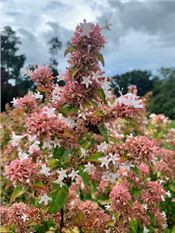Abelias Are Tough And Beautiful

HEATHER KIRK-BALLARD
LSU AgCenter Horticulturist
Flowering ornamental shrubs that require little to no effort are a prized possession of both homeowners and landscapers. One underutilized and underappreciated flowering shrub is the abelia.
Abelia is an evergreen to semievergreen shrub in the honeysuckle family. It is native to eastern Asia and southern North America with a few different species and hybrids. Commonly known as glossy abelia, its Latin name is Linnaea x grandiflora; it was previously known as Abelia x grandiflora.
Abelia has been described as a tough plant. One horticulturist and ornamental plant breeder from the University of Georgia, Carol Robacker, said, “Around here, we call abelia the gas station plant.
You could plant it beside a gas station surrounded by asphalt and forget about it, and it would still survive and thrive.”
Abelia is both tough and beautiful. Not only does it add beautiful foliage and color, but many of the cultivars are also fragrant. Abelia has been used in gardens throughout the United States. It grows in USDA hardiness zones 5 to 9. The newer selections are more compact and are profuse bloomers. This hardy shrub is both drought and erosion tolerant.
Depending on the cultivar, it can grow to 2 to 8 feet tall with a similar spread. There also are dwarf varieties. The new growth and fall foliage are reddish-bronze, and there are even gold-leaved and variegated varieties available.
One unique feature of the abelia is its growth habit: arching, open branches that cascade from the center of the plant. If you prefer a uniform look, prune and shape your abelia in late winter to early spring before new growth appears.
Blooms form on new wood in spring. They are tubular or bell-shaped in a variety of colors, growing in clusters at the ends of branches.
Abelia continues blooming into the fall and attract all sorts of pollinators.
Plant in cooler months from fall to spring in full sun for the most flower production. Abelia does well in part sun as well. Abelia prefers slightly acidic soil but is tolerant of a variety of soil types. Once established, this shrub is extremely heat and drought tolerant, making it an excellent selection for Louisiana.
Plants do not require fertilizer but will benefit from a spring application of organic, nutrient-rich compost or a slow-release, general-purpose granular application.
Several cultivars offer a variety of flower and foliage colors and sizes. Some examples of the traditional glossy abelia (L. x grandiflora) cultivars are Canyon Creek, a taller variety with copper- pink leaves and light rose pink flowers with red stems. Rose Creek has pink-purple leaves through summer and clusters of white, tube-shaped flowers that are fragrant from May to winter. Both are tough, have a nice fall foliage color change, have little to no pest or disease issues and are great as a foundation shrub selection, hedge or screen.
Then there are the Mexican abelias, of which there are two types to choose from: the A. Edward Goucher or the A. floribunda. The A. Edward Goucher cultivar is an evergreen to semi-evergreen plant that looks similar to the A. grandiflora, but is less hardy, lacier and more compact.
Some of the fragrant abelias are Canyon Creek and Bronze Anniversary, both with pink flowers. Two of the fragrant, compact cultivars are Golden Fleece and Kaleidoscope. Kaleidoscope is unique in that it has red stems and yellow, white and green variegated leaves with white flowers.
Dwarf selections make great container plant selections. Little Richard is a compact plant growing to 3 feet tall and wide with abundant small white flowers. Kaleidoscope and Twist of Lime are also great dwarf cultivars. Peach Perfection is another great compact cultivar with tri- color foliage on stunning, red stems. New growth emerges bright orange, eventually turning to yellow and green as it matures. The smaller size of these selections makes them a great selection for growing in patio containers or massed together to make a short hedge.
Lastly are the Chinese abelias (Linnaea chinensis), commonly a parent of many popular hybrids. It has a profuse bloom and is semievergreen in warmer climates. Some varieties can grow 5 to 7 feet tall and wide.
Flowers are typically white and pink with a nice fragrance.
For attractive foliage and months of blooms, add this workhorse of a shrub to your landscape. It is a great addition for pollinator interest and as a hedge or a foundation shrub planting. The abelia is no fuss but a true stunner. ∆